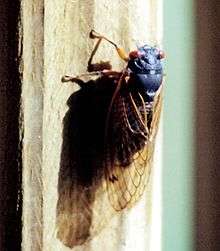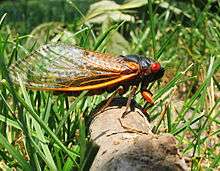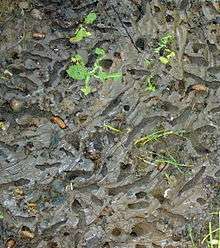Brood X
Brood X (Brood 10), the Great Eastern Brood, is one of 15 broods of periodical cicadas that appear regularly throughout the eastern United States. It has the greatest range and concentration of any of the 17-year cicadas.

Every 17 years, Brood X cicadas tunnel en masse to the surface of the ground, lay eggs, and then die off in several weeks. The combination of long dormancy, simultaneous emergence of vast numbers, and short period before the nymphs' burrowing underground to safety, allows the brood to survive even massive predation.[1]


Brood X's most recent appearance was in the spring and early summer of 2004 throughout an area roughly enclosed by Illinois, Michigan, New York and Georgia. The next regular appearances will be in 2021 and 2038.[1][2] However, significant numbers of periodical cicadas, believed to be Brood X emergents that were four years early, appeared throughout the brood's range in 2000 and in the Baltimore, Maryland-Washington, D.C., area in May 2017.[3]
History
Pehr Kalm, a Swedish naturalist visiting Pennsylvania and New Jersey in 1749 on behalf of his nation's government, observed in late May an emergence of Brood X.[4] When reporting the event in a paper that a Swedish academic journal published in 1756, Kalm wrote:
The general opinion is that these insects appear in these fantastic numbers in every seventeenth year. Meanwhile, except for an occasional one which may appear in the summer, they remain underground.
There is considerable evidence that these insects appear every seventeenth year in Pennsylvania.[4]
Kalm then described documents (including one that he had obtained from Benjamin Franklin) that had recorded in Pennsylvania the emergence from the ground of large numbers of cicadas during May 1715 and May 1732. He noted that the people who had prepared these documents had made no such reports in other years.[4] Kalm further noted that others had informed him that they had seen cicadas only occasionally before the insects appeared in large swarms during 1749.[4] He additionally stated that he had not heard any cicadas in Pennsylvania and New Jersey in 1750 in the same months and areas in which he had heard many in 1749.[4] The 1715 and 1732 reports, when coupled with his own 1749 and 1750 observations, supported the previous "general opinion" that he had cited.
Kalm summarized his findings in a paper translated into English in 1771,[5] stating:
There are a kind of Locusts which about every seventeen years come hither in incredible numbers .... In the interval between the years when they are so numerous, they are only seen or heard single in the woods.[6][7]
Moses Bartram described the 1766 emergence of Brood X in his Observations on the cicada, or locust of America, which appears periodically once in 16 or 17 years. Bartram noted that upon hatching from eggs deposited in the twigs of trees, the young insects ran down to the earth and "entered the first opening that they could find". He reported that he had been able to discover them 10 feet (3 m) below the surface, but that others had reportedly found them 30 feet (9 m) deep.[8]
In April 1800, Benjamin Banneker, who lived near Ellicott's Mills, Maryland, wrote in his record book that he recalled a "great locust year" in 1749, a second in 1766 during which the insects appeared to be "full as numerous as the first", and a third in 1783. He predicted that the insects "may be expected again in the year 1800, which is seventeen years since their third appearance to me".[9]
Popular culture
This is apparently the brood that emerged in 1936, inspiring Ogden Nash's poem "Locust-Lovers, Attention!", published in The New Yorker on June 20, 1936, and later reprinted in his collection I'm a Stranger Here Myself.[10]
Bob Dylan's song "Day of the Locusts" on his 1970 album New Morning refers to the Brood X cicadas that were present in Princeton, New Jersey, in June 1970 when Dylan received an honorary degree from Princeton University.[11]
References
- Post, Susan L. (Summer 2004). "A Trill of a Lifetime: More Information About the Periodical Cicada". Illinois Natural History Survey. Michael R. Jeffords (photos). Prairie Research Institute. Archived from the original on May 11, 2012. Retrieved July 1, 2011.
- Moore, Thomas E.; Walker, Thomas J. (April 27, 2001). "Genus Magicicada periodical cicadas". Singing Insects of North America. University of Florida Institute of Food and Agricultural Sciences. Archived from the original on September 30, 2008. Retrieved July 1, 2011.
- Dance, Scott (May 16, 2017). "As cicadas emerge four years early, scientists wonder if climate change is providing a nudge". The Baltimore Sun. Retrieved May 21, 2017.
- Davis, J.J. (May 1953). "Pehr Kalm's Description of the Periodical Cicada, Magicicada septendecim L., from Kongl. Svenska Vetenskap Academiens Handlinger, 17:101-116, 1756, translated by Larson, Esther Louise (Mrs. K.E. Doak)". The Ohio Journal of Science. 53: 139–140. hdl:1811/4028. Republished by Knowledge Bank: The Ohio State University Libraries and Office of the Chief Information Officer. Retrieved 2012-10-02.
- Kalm, Peter (1771). Travels into North America: Translated into English, By John Reinhold Foster. 2. London: T. Lowndess. pp. 212–213. Retrieved May 21, 2017 – via Google Books.
- Kalm, Peter (1771). Travels into North America: Translated into English, By John Reinhold Foster. 2. London: T. Lowndess. pp. 6–7. Retrieved May 21, 2017 – via Google Books.
- Marlatt, C.L. (1898). "The Periodical Cicada in Literature". The Periodical Cicada: An Account of Cicada Septendecim, Its Natural Enemies and the Means of Preventing its Injury, Together With A Summary of the Distribution of the Different Broods (Bulletin No. 14 - New Series, U.S. Department of Agriculture, Division of Entomology). Washington, D.C.: United States Government Printing Office. pp. 112–118. Retrieved May 21, 2017 – via Google Books.
- Bartram, Moses (1766). Observations on the cicada, or locust of America, which appears periodically once in 16 or 17 years. Communicated by the ingenious Peter Collinson, Esq. The Annual Register, or a View of the History, Politicks, and Literature, for the Year 1767. London: Printed for J. Dodsley (1768). pp. 103–106. OCLC 642534652. Retrieved May 21, 2017 – via Google Books.
- (1) Latrobe, John H. B., Esq. (1845). Memoir of Benjamin Banneker: Read before the Maryland Historical Society at the Monthly Meeting, May 1, 1845. Baltimore, Maryland: Printed by John D. Toy. pp. 11–12. OCLC 568468091. Retrieved October 7, 2015 – via Google Books.
(2) Barber, Janet E.; Nkwanta, Asamoah (2014). "Benjamin Banneker's Original Handwritten Document: Observations and Study of the Cicada". Journal of Humanistic Mathematics. 4 (1): 112–114. doi:10.5642/jhummath.201401.07. Retrieved August 26, 2014. - Nash, Ogden (June 20, 1936). "Locust-Lovers, Attention!". The New Yorker. Retrieved May 25, 2020.
- (1) Barron, James (June 4, 1996). "Cicadas: They're Back!". The New York Times. Retrieved April 8, 2013.
(2) "Are Periodical Cicadas Coming to Your Town - Magicicada Broods and Brood Maps". Cicadamania.com. Retrieved April 8, 2013.
(3) "Bob Dylan Receives Honorary Princeton Degree". Music News. Rolling Stone. July 9, 1970. Retrieved April 8, 2013.
(4) Barr, Cameron W. (March 28, 2004). "In D.C. Area. It's the Day Of the Cicada". The Washington Post. p. A1. Retrieved March 28, 2015.
Further reading
- "Selected Internet Resources – 17-Year Periodical Cicadas (2004)", Science Reference Services, Library of Congress
External links
- Brood X map
- 2011 Tennessee Cicadas: Noise and Mating
- Moore, Thomas E. (July 2, 2002). "Generalized distributions of extant 17-year broods of periodical cicadas". Singing Insects of North America. University of Florida Institute of Food and Agricultural Sciences. Archived from the original (figure) on August 28, 2008. Retrieved July 1, 2011.